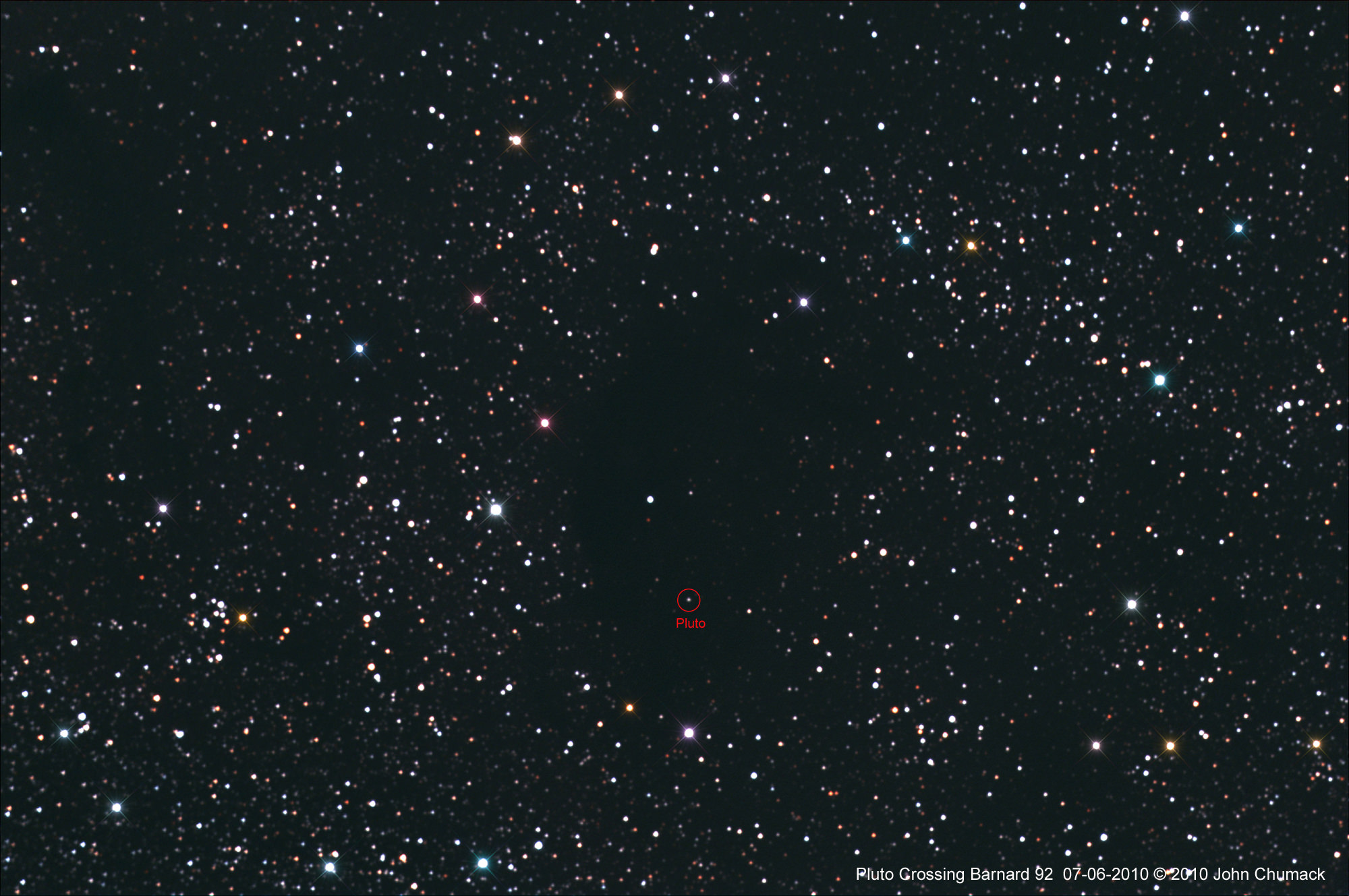[/caption]
Last week, Pluto passed in front of what looks like a dark patch in the sky, and astrophotographer John Chumack was ready to capture the event. The dark patch is actually Barnard 92, a dark nebula. Since Pluto is usually very hard to see among the background of stars, it stands out against this dark nebula which blocks out the background stars. Still, Pluto – distant and dim as it is – is just a faint point of light, so John took special measures. “Although Pluto was easily visible in a short 5 minute exposure, I took an hour exposure to show the Dark nebula and the ‘rich & pretty’ surrounding star field,” he said.
The image was taken from John’s observatory in Yellow Springs, Ohio, using his homemade 16” Newtonian telescope and a QHY8CCD single shot color camera, captured from 01:00am until 02:00 am E.S.T. on July 6, 2010. Pluto and B92 sits within the large Sagittarius Star Cloud, M24.
Great shot, John! For more wonderful astronomical images, check out John’s website, Galactic Images.


John and Nancy are right; dwarf planets are planets too. The term “dwarf planet” was first coined by New Horizons Principal Investigator Dr. Alan Stern to refer to a third class of planets in addition to terrestrials and jovians: objects massive enough to be rounded by their own gravity but not large enough to gravitationally dominate their orbits. A ridiculous vote by four percent of the IAU, most of whom are not planetary scientists, does not change this reality.
Yep, that’s Pluto alright. 🙂
I thought we weren’t calling this thing a planet. (see image caption)
That was John’s caption, so I used it. In my mind even a dwarf planet is still a planet..
I first read about this crossing a few days back, but haven’t seen it mentioned much. Here’s a GIF movie by Terry Evans in the UK: http://www.spaceweather.com/submissions/large_image_popup.php?image_name=Terry-Evans-Pluto-100703-a-100704-12-by-300s-SD-DDPAuto_1278330907.gif
Spaceweather.com had a gallery of images posted under PLUTO AND THE BLACK CLOUD: http://spaceweather.com/archive.php?view=1&day=06&month=07&year=2010
Some really nice views including John Chumack’s excellent image seen above.
In my opinion, there are too many people with way too much time… 😉
Well, seriously, this is an awesome photograph. It’s all about timing, similarly to those awesome pics of the ISS, etc.
Isn’t there a Pluto occultation coming up?
Of course not, and moreover it was that very process that defined those dwarf planets as characterized by a trait.
Even better, it defined a natural population of objects as planets, a more useful definition since it illuminates the pathways taken. It was also necessary since naming conventions are necessary but difficult, compare biology.
There can be no way that the later decision can be considered ridiculous. OTOH the former decision is ad hoc, initially raised by political and not scientific concerns, and risking the label.
The definitional divide is what the above comments touched, not whether a specific trait (of hydrostatic balance) exist or not.
Hello Nancy,
Your page is really useful.
I do not katch yet the photo with Pluto, I do not understand what is dark and what id lighted, as far as everything is in dark. The people that took the image are too close to this understanding to explain completely the point of view.
Regards,
Prof. Radu Rugescu
Hello Nancy,
Your page is really useful.
I do not katch yet the photo with Pluto, I do not understand what is dark and what is in light, as far as everything is in dark. The people that took the image are too close to this understanding to explain completely the point of view.
Regards,
Prof. Radu Rugescu
Hi nancy again,
What do you have with Obama? What is all this?
Radu